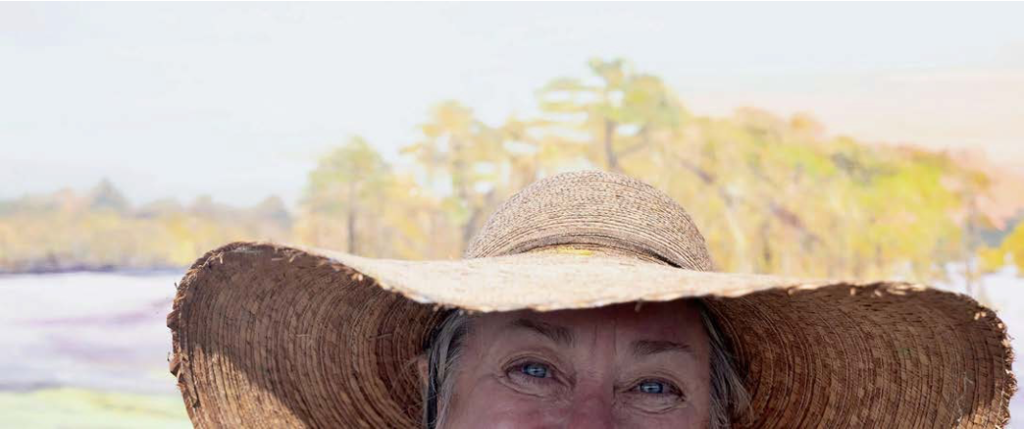
SC artist paints to oppose bridge project in Horry County
archive.is/20251102154320/https://www.postandcourier.com/myrtle-beach/news/waccamaw-bridge-artist-myrtle-beach-horry-sc/article_595326de-6bc0-4eb3-aa95-a6379846846c.html
By Janet Morgan jm*****@po************.com, Janet Morgan November 2, 2025
CONWAY — Smearing blues on a cake spatula, the artist studied the river and light on the cypress knees by an unnamed island.
She was clear about her intentions.
“What I’m doing is bringing emotion. It’s not a political battle. It’s an emotional battle,” Mary Edna Fraser said. “I’m like a closer. Artists have always been megaphones. Artists, poets, musicians, they shout out what’s really happening. What’s happening here is the Waccamaw River is at stake. These types of islands and viewpoints will be destroyed.”

Mary Edna Fraser of Charleston paints the Waccamaw River on a six-foot by three-foot canvas tied to a piling at the Bucksport Marina on Sept. 12, 2025. She is painting “plein air, painting outside in the elements. It’s French like the impressionists,” she said. Fraser is bringing awareness to the 16 proposed routes of the S.C. Highway 22 Extension, a 28-mile, four-lane highway to connect the south end of Horry County to S.C. 22. Fraser and other conservationists believe it will hurt the river and destroy communities.
Janet Morgan/Staff
She’s referring to a planned bridge project would span the Waccamaw and eventually connect with S.C. Highway 22.
Two historic Black communities sit on opposite sides of the tea-colored river: Bucksport to the
north and Burgess to the south. The communities are about 35 miles apart by road, but only about five miles by river.
Many locals and conservationists fear the bridge will forever alter these communities. Fraser
hopes to highlight those concerns with her art.
“When I came up from Charleston, I started crying,” she said. “It’s so beautiful. We don’t have a lot of just plain old farmland this close to the coast to feed us. The homes and churches are so beautiful, and you can tell people take pride in that.
“Myrtle Beach’s growing faster than any other place in America. This is a developer’s dream, right? A developer would want this to be a bedroom community of cookie cutter homes and condominiums so you wouldn’t even see the sky.”
Decades of watching the Waccamaw
For more than half her life, Mary Owens has heard talk about a bridge connecting the South Strand to Bucksport.
The chatter swelled up 20 years ago and now the 87-year-old is still fighting the same battle to protect her community that stretches from U.S. Highway 701 to the river near the Georgetown County line. It’s home. It’s where she has prayed and put family in the dirt. It’s as much a part of her as she a part of it.
“We’re not just sitting back waiting to see what they’ll do,” Owens said. “They call themselves raising roads. I’ve been around many, many years. It comes up every few years, doesn’t it? I don’t think they know but they keep bringing up Bucksport and Burgess.”

Mary Edna Fraser of Charleston paints with various tools at the Bucksport Marina on Sept. 12, 2025. She is painting “Waccamaw” to bring awareness to the 16 proposed routes of the S.C. Highway 22 Extension, a 28-mile, four-lane highway to connect the south end of Horry County to S.C. 22. Fraser and other conservationists believe it will hurt the river and destroy communities.
Janet Morgan/Staff
Owens remembers the bridge talk growing louder just two years after S.C. 22 opened in 2001. There were community meetings, studies ordered and funding discussions at the county and state levels. Officials said there needed to be a hurricane evacuation route for the growing South Strand while simultaneously making a beltway that would relieve traffic around Myrtle Beach.

Life-long Bucksport resident Mary Owens talks with artist and conservationist Mary Edna Fraser of Charleston at the Bucksport Marina on Sept. 12, 2025.
Janet Morgan/Staff
Talks turned into 28 alternate routes in 2008, a list that was whittled down to 16 options. Ten of those would bisect Burgess and Bucksport for the 28-mile, four-lane S.C. Highway 22 Extension. “They’re doing that on purpose to confuse people. It looks like a plate of noodles, the map and all those routes,” Fraser said. “It makes people think, ‘They won’t come to my home. They won’t take my home. Look how many other alternatives they have. It won’t be me.'”

Mary Edna Fraser of Charleston paints the Waccamaw River on a six-foot by three-foot canvas tied to a piling at the Bucksport Marina on Sept. 12, 2025. She is painting “plein air, painting outside in the elements. It’s French like the impressionists,” she said. Fraser is bringing awareness to the 16 proposed routes of the S.C. Highway 22 Extension, a 28-mile, four-lane highway to connect the south end of Horry County to S.C. 22. Fraser and other conservationists believe it will hurt the river and destroy communities.
Janet Morgan/Staff
Owens said she is not opposed to growth, new roads or change. She’s not even one of the “not in my backyard” types.
“I do think there are other ways that don’t destroy history,” the self-described community historian
said. “Bucksport and Burgess are important.” Fraser held Owens’ hand and looked in her eyes.
“You can stop this,” the artist said. “Push their buttons. If we get 1,000 or 2,000 people to
comment, sign a petition, it will stop it. They will not build it. It worked on 526 in Charleston.”
In May, the state Transportation Infrastructure Bank Board voted unanimously to kill a $2.3 billion extension project to carry Interstate 526 from West Ashley to James and Johns islands. The project intended to cut down on traffic congestions had threatened to slice historic communities and impact 38 acres of wetlands.
Charleston County voters last fall roundly rejected another penny sales tax that would have funded the project.
But Horry County voters went the other way by approving a 1 percent sales tax to fund road improvement projects in a county that is expected to hold more than 600,000 people by 2035. On the list was $1.56 billion for a road and bridge project linking the South Strand with western Horry.
Raising awareness through art
Urging Owens and community members on, Fraser has her own way of fighting against and drawing attention to the S.C. Highway 22 Extension.
Perched on the end of a dock at the Bucksport Marina, the Charleston artist painted from dawn until dusk for a week.
On Sept. 12, Fraser blended orange and pink to match the sunset hues. She mixed her creations on a plate atop an antique ironing board and gently placed the paint on a cake-decorating offset spatula.

Mary Edna Fraser of Charleston paints the Waccamaw River on a six-foot by three-foot canvas tied to a piling at the Bucksport Marina on Sept. 12, 2025. She is painting “plein air, painting outside in the elements. It’s French like the impressionists,” she said. Fraser is bringing awareness to the 16 proposed routes of the S.C. Highway 22 Extension, a 28-mile, four-lane highway to connect the south end of Horry County to S.C. 22. Fraser and other conservationists believe it will hurt the river and destroy communities.
Janet Morgan/Staff
The scene unfolding on her 6-foot-by-3-foot canvas can be seen on her website or through the Coastal Conservation League’s website.
To Fraser, the purpose of the paintings she does quietly in out-of-the-way locations isn’t so much about the composition and colors. The purpose is to bring attention to conservation.
“It’ll go in shows, whenever I have shows. It’ll go on my website,” she shrugged. “Somebody will buy it maybe after I’m dead. It really doesn’t matter. It’s about this, here, this place and keeping it preserved.”
Fraser isn’t unfamiliar with the Grand Strand. In 2023, she wore snake boots and set up in the middle of the woods in Lewis Ocean Bay Heritage Preserve off International Drive to paint another scene over five days.
That painting was to bring attention to Conway Medical Center’s plan to build a hospital across from the preserve.

Mary Edna Fraser of Charleston paints the Waccamaw River on a six-foot by three-foot canvas tied to a piling at the Bucksport Marina on Sept. 12, 2025. She is painting “plein air, painting outside in the elements. It’s French like the impressionists,” she said. Fraser is bringing awareness to the 16 proposed routes of the
S.C. Highway 22 Extension, a 28-mile, four-lane highway to connect the south end of Horry
County to S.C. 22. Fraser and other conservationists believe it will hurt the river and destroy communities.
Janet Morgan/Staff
Becky Ryon of the conservation league said in addition to Fraser’s painting drawing attention to the issue, about 25,000 people signed a petition asking the provider not to build on the land.
In June, the hospital sold 353 acres to the S.C. Department of Natural Resources placing it under
permanent protection from development.
Spanning over 10,000 acres, the Lewis Ocean Bay Heritage Preserve has 23 Carolina bays, oval depressions unique to the area. It has Venus flytraps, longleaf pines and 150 plant species in a single square meter.
“So, you see, it works,” Fraser said clicking off the I-526 and Lewis Ocean Bay wins. “It can be done. It can be stopped. We can keep the beautiful and important parts.”

ENERGY FROM HEAVEN NOT HELL
Environmentalist Bill McKibben offers HOPE